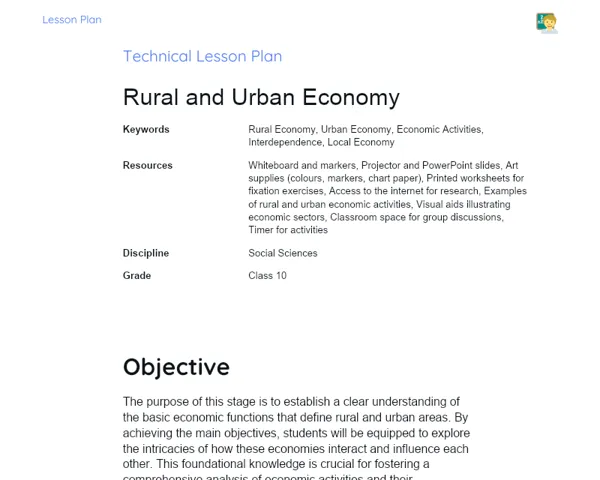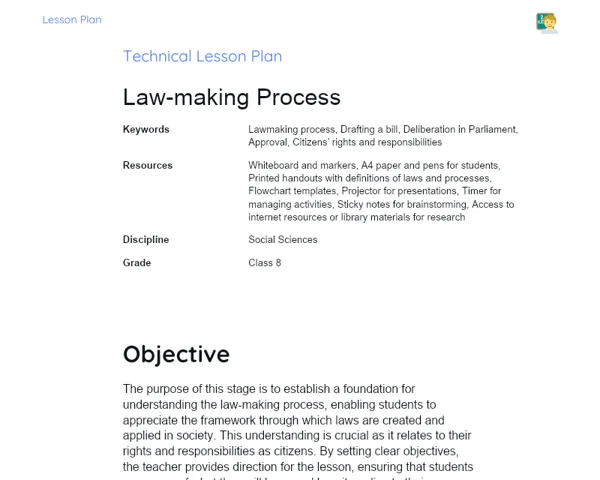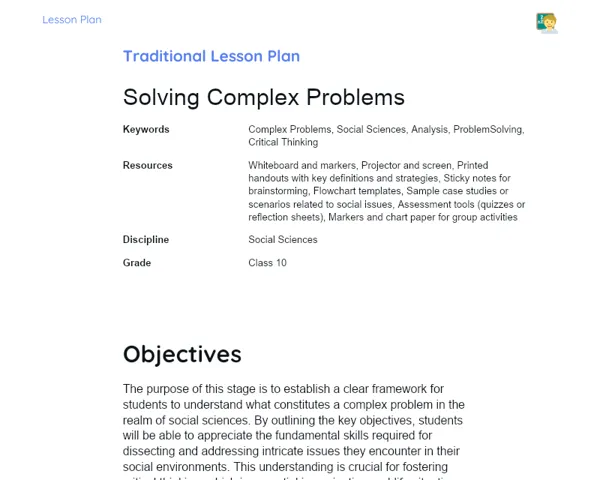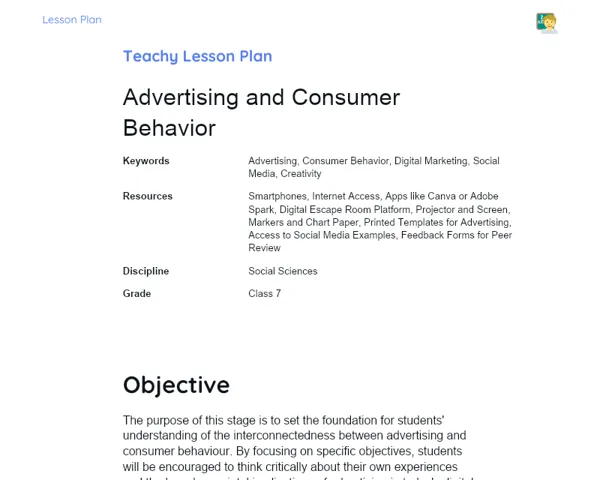Lesson Plan | Teachy's Iteractive Lesson Plan | Advertising and Consumer Behavior
| Keywords | Advertising, Consumer Behavior, Digital Marketing, Social Media, Creativity, Collaboration, Critical Thinking, Engagement, Real-World Applications, Interactive Learning |
| Resources | Smartphones, Internet Access, Apps like Canva or Adobe Spark, Digital Escape Room Platform, Projector and Screen, Markers and Chart Paper, Printed Templates for Advertising, Access to Social Media Examples, Feedback Forms for Peer Review |
| Codes | - |
| Grade | Class 7 |
| Discipline | Social Sciences |
Objectives
Duration: 15 - 20 minutes
The purpose of this stage is to set the foundation for students' understanding of the interconnectedness between advertising and consumer behaviour. By focusing on specific objectives, students will be encouraged to think critically about their own experiences and the broader societal implications of advertising in today's digital context. This will help to deepen their engagement and personal connection to the topic, allowing them to explore the complexities of consumerism in a relatable manner.
Main Objectives:
1. Enable students to identify and analyse how advertising strategies influence consumer behaviour and preferences.
2. Encourage students to critically evaluate the impact of advertising on their own purchasing decisions and societal trends.
Introduction
Duration: 15 - 20 minutes
The purpose of this stage is to engage students in a lively discussion that builds a foundation for understanding the intricate relationship between advertising and consumer behavior. By encouraging them to draw on their personal experiences and the facts they discover, this section aims to enhance their critical thinking and connect classroom learning to real-world applications. This dynamic interaction will help students to feel invested in the lesson, paving the way for further exploration of advertising strategies within the digital landscape.
Warming Up
To kick-start the session on Advertising and Consumer Behavior, the teacher will encourage students to use their smartphones to search for an intriguing fact about advertising. This could be a recent statistic, a new trend, or an innovative advertising method. Each student will share their findings with the class, fostering curiosity and setting the stage for deeper discussions about how these facts relate to their own experiences and daily lives.
Initial Thoughts
1. How do you think advertisements influence your choices in daily life?
2. Can you recall a specific advertisement that made you want to buy something? What was it and why?
3. In your opinion, do advertisements reflect or shape consumer preferences?
4. Have you ever felt pressured to buy something because of an advertisement? Can you share that experience?
5. How do you think social media has changed the way we perceive advertisements?
Development
Duration: 70 minutes
The purpose of this stage is to immerse students in a hands-on, interactive environment where they can apply their acquired knowledge of advertising and consumer behavior. By engaging in creative tasks that utilize technology, students will not only reinforce their understanding but also develop critical skills such as collaboration, problem-solving, and effective communication. This stage aims to deepen their insight into how advertising strategies are crafted and how they affect consumer choices in the digital age.
Activity Suggestions
Activity Recommendations
Activity 1 - Ad Creators Battle Royale
> Duration: 60 - 70 minutes
- Goal: To enable students to apply their understanding of advertising strategies in a practical project, fostering creativity and collaboration while evaluating how design elements influence consumer behavior.
- Activity Description: In this dynamic team challenge, students will become advertising experts tasked with creating a digital advertisement for a fictional product. Each group will choose a product category (like snacks, tech gadgets, or eco-friendly items) and develop both visual and textual content for their ad. Students will use apps like Canva or Adobe Spark to design posters and create short video advertisements that highlight their product's unique selling points and appeal to the target audience. After elements are prepared, they will present their ads to the class and receive feedback based on creativity, originality, and impact.
- Instructions:
-
- Divide the class into groups of up to 5 students.
-
- Each group selects a product category.
-
- Use Canva or Adobe Spark to create a digital advertisement (poster or video).
-
- Include elements like catchy slogans, visuals, and details on the target audience.
-
- Prepare a presentation explaining the design choices and marketing strategy.
-
- Present the ads to the class for feedback.
Activity 2 - Social Media Influencer Challenge
> Duration: 60 - 70 minutes
- Goal: To help students understand the role of social media in shaping consumer behavior while encouraging them to creatively connect with their peers through visual storytelling.
- Activity Description: Each group will simulate the role of social media influencers, tasked with promoting a product through creative posts that resonate with their followers. Students will brainstorm a product and create a series of Instagram posts (images, captions, hashtags) that can attract attention and engage potential consumers. They will learn how to connect product features to consumer needs, using insights from their research on successful influencer marketing.
- Instructions:
-
- Form groups of 5 and pick a product to promote.
-
- Research effective influencer strategies used in real-life scenarios.
-
- Create 3-5 Instagram-style posts, including visuals and engaging captions.
-
- Choose appropriate hashtags to maximize reach.
-
- Present your influencer marketing strategy and posts to the class.
Activity 3 - The Advertising Escape Room
> Duration: 60 - 70 minutes
- Goal: To promote teamwork and critical thinking while reinforcing understanding of advertising techniques and consumer influence through interactive problem-solving.
- Activity Description: In this engaging activity, students will participate in a digital escape room designed around advertising concepts. The escape room will contain various puzzles based on advertisements, such as decoding slogans, identifying brands from visual clues, and analyzing consumer behavior scenarios. Each puzzle solved will provide a clue to unlock the final challenge, where teams create a cohesive advertising campaign for a chosen theme.
- Instructions:
-
- Divide the class into teams of 5.
-
- Access the digital escape room platform designed for this activity.
-
- Work as a team to solve puzzles related to advertising and consumer choices.
-
- Once all puzzles are solved, brainstorm a campaign based on themes encountered.
-
- Summarize the campaign to share with the class.
Feedback
Duration: 20 - 25 minutes
The purpose of this stage is to foster an environment of collaborative learning through discussion and reflective feedback. By sharing experiences and insights, students will consolidate their understanding of advertising and its effects on consumer behavior. This interaction encourages critical thinking while providing an opportunity for peer-to-peer learning, enabling students to appreciate diverse perspectives and grasp the complexities of marketing in the digital landscape.
Group Discussion
Now that we've completed our activities, let's come together to share our insights! I invite each group to present what they learned from the advertisements they created and how these strategies may impact consumer decisions. Consider how your creative process reflected the principles of advertising we discussed. Who would like to start?
Reflections
1. What was the most surprising thing you learned about how advertisements are crafted to influence buyers? 2. Which advertising strategy did your group find to be most effective in appealing to your target audience, and why? 3. How do you think your understanding of consumer behavior has changed after participating in this lesson?
360º Feedback
As we conclude, it's important to support one another with constructive feedback. Please take a moment to share with your group one aspect you appreciated about each other’s presentations and suggest one area for improvement. Remember to keep your feedback respectful and focus on how each member can grow.
Conclusion
Duration: 15 - 20 minutes
The purpose of this stage is to wrap up the lesson with an engaging and reflective discussion that reinforces the key takeaways from the day's activities. By summarizing content creatively, connecting it with real-world applications, and emphasizing its relevance in students' lives, this conclusion aims to solidify their understanding of advertising's powerful role in shaping consumer behavior. This closing reflection also encourages them to carry these insights beyond the classroom and into their everyday interactions with media and advertisements.
Summary
In today's roller-coaster ride through the vibrant world of Advertising and Consumer Behavior, students transformed into savvy marketers! They discovered how clever ads can tickle our emotions, shape our desires, and even sneak into our wallets when we least expect it. With creativity unleashed, teams crafted dazzling digital advertisements, mimicked trendy social media influencers, and cracked the code in an exciting advertising escape room. Each student became a storyteller armed with persuasive slogans and eye-catching visuals, ready to engage consumers in the digital marketplace!
World
In today's fast-paced digital landscape, understanding Advertising and Consumer Behavior has never been more critical. From TikTok trends to Instagram reels, advertisements now come alive on platforms frequented by the youth, shaping opinions and lifestyle choices in real-time. As students dive into these dynamics, they gain insights into not just the mechanics of advertising but also its ability to reflect societal values, consumer needs, and the cultural shifts occurring globally. This lesson was not just about ads; it was about navigating a world where marketing is an integral part of everyday life.
Applications
The importance of understanding advertising extends beyond just what meets the eye. It equips students with the ability to critically assess the messages they encounter daily, helping them to make informed choices as consumers. From selecting snacks marketed as 'healthy' to understanding the allure of flashy gadgets, this knowledge empowers students to discern between genuine value and clever marketing ploys. In essence, mastering the art of advertising literacy cultivates not only savvy consumers but also informed citizens capable of navigating a consumer-driven society.



